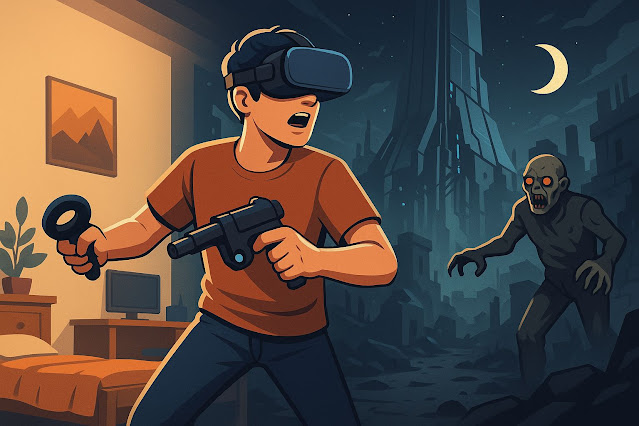From Pixels to VR: How Game Genres Adapt to New Technologies
The game industry has always been a playground for innovation. From the humble beginnings of pixelated arcade games to today’s immersive virtual reality (VR) experiences, technology has consistently reshaped how we play. With the rise of VR, artificial intelligence (AI), and cloud gaming, entire game genres are evolving—some being reinvented entirely. Let’s explore how these technological leaps are redefining the boundaries of game genres as we know them.
1. Virtual Reality (VR): Turning Genres Into Full-Body Experiences
Virtual Reality has done more than just offer a new way to display games—it has redefined how players experience them.
🎮 FPS Games Become Physical
First-person shooters (FPS) like Doom or Call of Duty once relied solely on mouse precision and quick reflexes. Now, games like Half-Life: Alyx or Pavlov VR require actual body movement. Ducking, leaning, aiming, and even reloading your weapon become physical actions. This shift has turned passive gameplay into active engagement.
🧩 Puzzle Games Take On a Spatial Dimension
VR has also elevated puzzle games. Titles like The Room VR or I Expect You To Die use spatial reasoning in ways that 2D puzzle games never could. Players manipulate 3D objects, investigate physical clues, and solve puzzles using hand tracking—turning what was once a mental exercise into a sensory experience.
💃 Rhythm and Music Games Go Full-Body
Games like Beat Saber and Synth Riders are genre-defining examples of how VR creates hybrid experiences. These rhythm-based games aren't just about timing—they’re about choreography, reaction speed, and physical endurance.
2. AI in Games: Dynamic Worlds and Smarter Enemies
Artificial Intelligence has long powered enemy behavior, but new advancements are making AI integral to gameplay and storytelling.
🧠 RPGs and Strategy Games with Smarter Opponents
AI is revolutionizing RPGs and strategy games by making enemy behavior adaptive. In Total War: Warhammer or XCOM 2, AI responds to your tactics in real time, learning from your choices. This introduces unpredictability that wasn’t possible with older, script-based systems.
💬 Emergent Narrative in Story-Driven Games
AI-driven characters can now engage players with dynamic dialogue and decision-making. In games like AI Dungeon or Fabledom, generative AI creates story branches or NPC conversations on the fly, allowing players to co-write their own adventures.
🎭 AI-Powered NPCs in Open Worlds
Imagine an open-world RPG where every townsperson has a unique personality, daily routine, and memory of past interactions. AI is enabling this depth. It’s not far-fetched anymore—games like Watch Dogs: Legion already feature semi-randomized, recruitable NPCs with individual traits and backstories, hinting at a future where AI fills game worlds with believable, reactive characters.
3. Cloud Gaming: Genre Access Without Boundaries
Cloud gaming platforms like Xbox Cloud Gaming, NVIDIA GeForce NOW, and PlayStation Now have removed the barrier of expensive hardware and enabled genres to reach broader audiences.
🕹️ Expanding Access to AAA Titles
Previously, high-spec genres like open-world RPGs or large-scale MMOs were limited to those with powerful rigs. Cloud gaming democratizes access. Players can now experience games like Cyberpunk 2077 or Elden Ring on mobile devices or low-end PCs.
🤝 Reimagining Multiplayer and Co-op Games
Cloud gaming's low-latency architecture is helping multiplayer genres scale faster. With less dependency on local installations and updates, co-op games can reach new audiences instantly. Games like It Takes Two or Destiny 2 are increasingly being enjoyed through cloud platforms without any download wait.
🧪 Experimentation with Genre Hybrids
Because developers don’t have to optimize for every hardware configuration, cloud-native games can push genre boundaries. Studios are now free to experiment with complex simulations or hybrid experiences that combine strategy, survival, and RPG mechanics—without worrying about performance bottlenecks on user-end machines.
4. Genre Fusion: The Natural Result of New Tech
As these technologies evolve, we’re seeing game genres merge and transform into new forms.
🌌 VR + Survival Horror = Immersion Overload
Traditional survival horror games like Resident Evil have taken a new form in VR. When you can’t just turn away from the screen—when the monster is right there in 3D—the genre’s tension reaches new psychological heights.
🤖 AI + Sandbox Games = Infinite Replayability
Sandbox genres like Minecraft or No Man’s Sky are now incorporating procedural AI to create living, breathing ecosystems. In these games, AI-driven animals, NPCs, and even terrain react and evolve, giving players a unique experience each time they log in.
☁️ Cloud + Roguelike = Persistent, Shared Worlds
Cloud technology is making it easier to host persistent game worlds. Now imagine a roguelike where each death slightly alters the game world for all players, and that evolution is hosted in the cloud. Developers are beginning to toy with these ideas, blurring lines between genres and platforms.
5. Challenges and Considerations
Of course, adapting genres to new tech isn’t without its hurdles.
-
Accessibility: Not all players can afford VR headsets or have fast enough internet for cloud gaming.
-
Motion Sickness and Fatigue: VR can make some genres physically or visually overwhelming.
-
AI Ethics and Behavior: Unchecked generative AI in narrative or moderation can lead to unintended content.
-
Preservation of Design: Not every genre benefits equally—some classic genres may lose their charm or gameplay clarity when forced into immersive formats.
The key is balance—finding ways to enhance the genre experience without diluting what made it fun in the first place.
Conclusion: The Genre Evolution Is Just Beginning
From the pixelated simplicity of Space Invaders to the immersive worlds of Boneworks, game genres have never stopped evolving. With technologies like VR, AI, and cloud gaming leading the charge, we are witnessing the rebirth of old genres and the birth of entirely new ones.
Game designers today are no longer confined by screen size or hardware limitations. They're architects of entire experiences—ones that think, learn, and immerse in ways we once only dreamed of.
Whether you're a player or a creator, one thing is clear: the future of game genres is not just about pushing buttons—it's about pushing boundaries.


%20in%20game%20development.%20The%20image%20features%20a%20digital%20bluepri.webp)
Comments